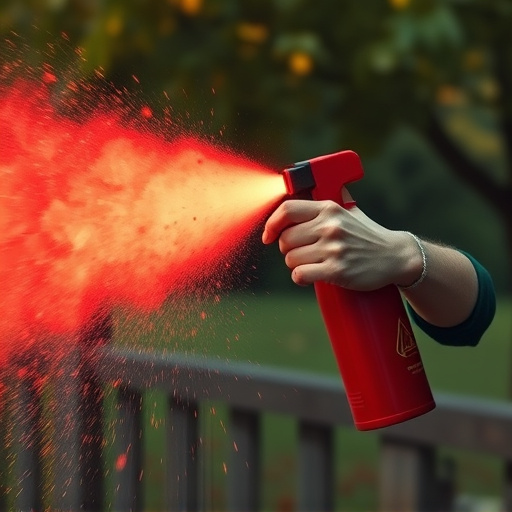Capsaicin, the active ingredient in chili peppers, offers a non-lethal self-defense option through its unique disruption of pain receptors in eyes and mucous membranes. The best pepper spray self-defense techniques involve precise aiming at sensitive areas like eyes and face from 3-4 inches away, with regular practice for enhanced accuracy. Legal considerations and responsible use guidelines, including checking local laws, proper application, storage, and maintenance, are paramount for safe deployment of capsaicin-based crowd control sprays.
Discover the power of nature’s defense mechanism with capsaicin-based inflammatory crowd control spray—a revolutionary self-defense tool. This article explores the science behind this potent compound, its effectiveness in deterring assailants, and best practices for optimal protection. Learn about legal considerations and responsible use guidelines to equip yourself with the most effective pepper spray self-defense techniques.
- Understanding Capsaicin: The Science Behind the Spray
- Pepper Spray's Role in Self-Defense Strategies
- Effective Application Techniques for Optimal Protection
- Legal Considerations and Responsible Use Guidelines
Understanding Capsaicin: The Science Behind the Spray
Capsaicin, the active ingredient in chili peppers, is a potent compound that has gained significant attention for its crowd-control capabilities. When incorporated into self-defense sprays, capsaicin creates an effective and non-lethal deterrent. The science behind this innovative approach lies in its ability to target the body’s pain receptors. Upon contact with the eyes or mucous membranes, capsaicin binds to these receptors, inducing a strong sensory response characterized by intense burning sensations and tears.
This reaction is swift and can quickly disrupt and disperse a crowd. For individuals seeking the best pepper spray self-defense techniques, capsaicin offers a strategic advantage due to its precise targeting of pain pathways. Unlike traditional pepper sprays that rely on irritants affecting the respiratory system, capsaicin’s mechanism focuses on localizing the impact, making it a game-changer in personal safety and crowd control scenarios.
Pepper Spray's Role in Self-Defense Strategies
Pepper spray, a potent chemical compound derived from chili peppers, has become an indispensable tool in self-defense strategies for many individuals seeking effective crowd control and personal protection. Its unique ability to induce a burning sensation and temporary incapacitation makes it a powerful deterrent against potential threats. When deployed correctly, pepper spray can give users the crucial time and distance needed to escape dangerous situations.
The best pepper spray self-defense techniques involve understanding its application and safe handling. Users should aim for the eyes, face, and respiratory system, as these areas are particularly sensitive to capsaicin, the active ingredient in pepper spray. Proper training ensures individuals can utilize this tool effectively while minimizing the risk of causing unnecessary harm. With proper knowledge and practice, pepper spray can be a game-changer in self-defense scenarios, offering individuals the confidence and capabilities to defend themselves in various situations.
Effective Application Techniques for Optimal Protection
For optimal protection, mastering effective application techniques is crucial when using a capsaicin-based inflammatory crowd control spray, also known as pepper spray for self-defense. The key lies in aiming precisely at the eyes and face of the assailant. A quick and direct shot is ideal; hold the can upright, about 3–4 inches away from your target, and pull the trigger firmly. This method ensures maximum irritation and disorientation of the attacker, giving you valuable time to escape or seek assistance.
To enhance effectiveness, practice these best pepper spray self-defense techniques. Ensure you have a clear line of sight, allowing for accurate targeting. Regular training in different application scenarios, such as moving targets or in confined spaces, can significantly improve your response time and accuracy. Remember, proper usage goes beyond just spraying; it’s about strategic deployment to neutralize the threat while prioritizing safety and minimizing collateral damage.
Legal Considerations and Responsible Use Guidelines
When considering the best pepper spray self-defense techniques, it’s crucial to understand the legal considerations and responsible use guidelines surrounding this powerful tool. The legality of carrying and using pepper spray varies widely by jurisdiction, so understanding local laws is essential before purchasing or employing such a device. Some areas have strict restrictions on the type, quantity, and strength of pepper spray allowed for civilian use, while others have more permissive policies.
Responsible use guidelines emphasize the importance of proportionate force and safety. Users should be trained in proper application techniques to ensure maximum effectiveness and minimize risks. This includes awareness of safe handling practices, storage, and disposal methods. Additionally, responsible usage involves targeting specific body areas (e.g., face, eyes) while avoiding non-target areas to prevent unnecessary harm or injury. Regular maintenance and inspection of the spray device are also vital to guarantee its reliability in emergency situations.
Capsaicin-based inflammatory crowd control spray, often referred to as pepper spray, is a powerful tool in self-defense strategies. By understanding its science, learning effective application techniques, and being aware of legal considerations, individuals can leverage the best pepper spray self-defense techniques for optimal protection. Responsible use guidelines are paramount to ensuring public safety and personal well-being.
